
Bellona is a large main-belt asteroid. It was discovered by German astronomer R. Luther on March 1, 1854, and named after Bellōna, the Roman goddess of war; the name was chosen to mark the beginning of the Crimean War. It is a stony (S-type) asteroid with a cross-section size of around 100–120 km. 28 Bellona is orbiting the Sun with a period of 4.63 years.

Melete is a large and dark main belt asteroid. It is a rather unusual P-type asteroid, probably composed of organic rich silicates, carbon and anhydrous silicates, with possible internal water ice. The asteroid orbits the Sun with a period of 4.18 years.
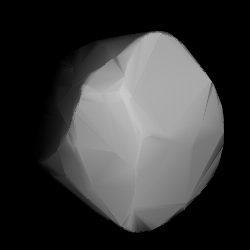
Bertha is a main-belt asteroid. It was discovered by the French brothers Paul Henry and Prosper Henry on 4 November 1875, but the credit for the discovery was given to Prosper. It is probably named after Berthe Martin-Flammarion, sister of the astronomer Camille Flammarion.
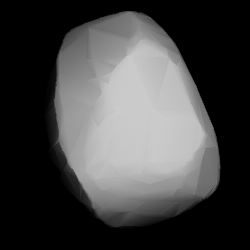
164 Eva is a main-belt asteroid that was discovered by the French brothers Paul Henry and Prosper Henry on July 12, 1876, in Paris. The reason the name Eva was chosen remains unknown. The orbital elements for 164 Eva were published in 1877 by American astronomer Winslow Upton. It is categorized as a C-type asteroid and is probably composed of primitive carbonaceous chondritic materials.

Maria is a Main belt asteroid that was discovered by French astronomer Henri Joseph Perrotin on January 10, 1877. Its orbit was computed by Antonio Abetti, and the asteroid was named after his sister, Maria. This is the namesake of the Maria asteroid family; one of the first asteroid families to be identified by Japanese astronomer Kiyotsugu Hirayama in 1918.
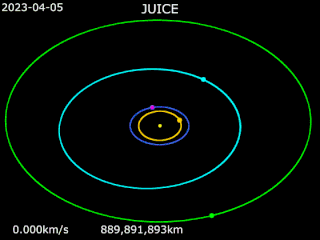
Rosa is a large Themistian asteroid. It is classified as a combination of C-type and P-type asteroids, so it is probably composed of carbonaceous material rich in water ice. It was discovered by Johann Palisa on 9 March 1882, in Vienna. The origin of the name is not known.
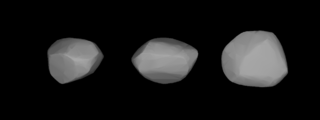
Kriemhild is a main belt asteroid that was discovered by Austrian astronomer Johann Palisa on 22 September 1884 in Vienna and was named after Kriemhild, a mythological Germanic princess, by Moriz von Kuffner, a Viennese industrialist and sponsor of astronomy.

Atropos is a typical Main belt asteroid that was discovered by Austrian astronomer Johann Palisa on 8 March 1888 in Vienna.
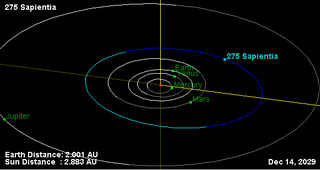
Sapientia is a very large Main belt asteroid that was discovered by Johann Palisa on 15 April 1888 in Vienna. It is classified as a C-type asteroid and is probably composed of carbonaceous material. It is named for the Roman personification of wisdom, Sapientia.

Siri is a main belt asteroid in orbit around the Sun. It was discovered by German astronomer Max Wolf on 19 March 1892 in Heidelberg. The origin of this asteroid's name is unclear. On October 5, 2092, 332 Siri will pass 4,981,670 km (3,095,470 mi) from the asteroid 29 Amphitrite with a relative velocity of 2.054 kilometers per second.
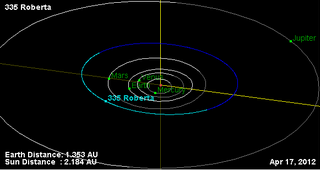
Roberta is a large main belt asteroid. It was discovered on 1 September 1892, by German astronomer Anton Staus at Heidelberg Observatory. Roberta was the 12th asteroid that was discovered using photography, and the only asteroid discovery made by Staus.

Eduarda is a main belt asteroid that was discovered by German astronomer Max Wolf on 25 September 1892 in Heidelberg. It was named after German banker and amateur astronomer Heinrich Eduard von Lade.
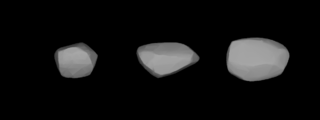
Rebekka is a minor planet orbiting the Sun, which was discovered on September 19, 1905, by a German astronomer Paul Götz in Heidelberg. It was named after a young lady from Heidelberg, and may have been inspired by the asteroid's provisional designation 1905 RB.

708 Raphaela is a minor planet orbiting the Sun.

747 Winchester is an asteroid, a minor planet orbiting the Sun. It was discovered in 1913, and is named after the town in which it was discovered, Winchester, Massachusetts, in the USA.
839 Valborg is a mid-sized S-type Eunomian asteroid. Its diameter is about 20 km, its albedo of 0.353 is very high for an asteroid. Its rotation period is 10.366 hours.
947 Monterosa is a minor planet orbiting the Sun.
2131 Mayall is an inner main-belt asteroid discovered on September 3, 1975, by Arnold Klemola at the Lick Observatory and named in honor of Nicholas U. Mayall (1906–1993), director of the Kitt Peak National Observatory during 1960–1971, who also worked at Lick for many years. It is about 8 km in diameter.
5641 McCleese, provisional designation 1990 DJ, is a rare-type Hungaria asteroid and slow rotator, classified as Mars-crosser from the innermost regions of the asteroid belt, approximately 4 kilometers in diameter.
13025 Zürich, provisional designation 1989 BA, is a stony Phocaea asteroid from the inner regions of the asteroid belt, approximately 5 kilometers in diameter. It was discovered on 28 January 1989, by Swiss astronomer Paul Wild at Zimmerwald Observatory near Bern, Switzerland, and later named for the Swiss city of Zürich.















